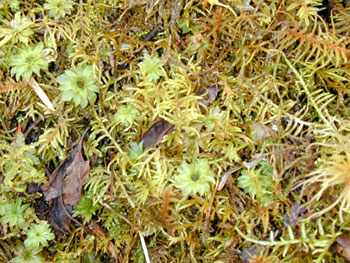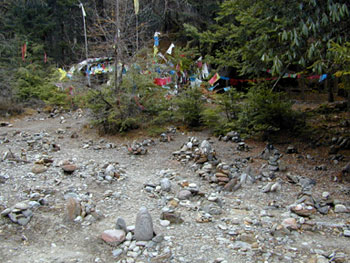A Village Near the Sky
Greater Tibet (Yunnan, China), 2002
Part 2 of 3
Go to: Part 1 - Part 2 - Part 3
[Full story also available as a PDF download]
Our sympathies lie with Ana Zhu and Ahqing as we climb toward a lake high on the slopes of Meili. Ana Zhu has warned that snow will reach our knees. He has not prepared us to sink hip-deep as we descend the north side of a 13,000-foot ridge, heading for the grazer’s huts where we will spend the night. “No one comes here until May,” Ana Zhu’s brother-in-law informs us. He has been deputed as our guide, complying with a new regulation that someone from the village must accompany campers. The rule is designed to protect ourselves as well as the environment, and perhaps to put a little cash in local pockets. “You are lucky the snow is light this year.”
The tongue of a massive glacier lashes down the mountain. The ice spilling from its headwall will keep us from reaching the lake. “Too dangerous,” Ana Zhu has indicated, and instructed his brother-in-law to let us climb no higher than the  huts. We have reluctantly agreed. Our destination, albeit shortened, does not disappoint us. A dozen shacks dot a snow-packed meadow. The season has warmed enough for a stream to be flowing along its south side. To the west, a cirque extends 180 degrees around, Kawagebo on the left and a coxcomb ridge at center, both almost two miles above our heads. The pale afternoon sun illuminates an explosion of white powder halfway down the peak. All night, we will hear the crack of ice and snow tumbling down the mountains.
huts. We have reluctantly agreed. Our destination, albeit shortened, does not disappoint us. A dozen shacks dot a snow-packed meadow. The season has warmed enough for a stream to be flowing along its south side. To the west, a cirque extends 180 degrees around, Kawagebo on the left and a coxcomb ridge at center, both almost two miles above our heads. The pale afternoon sun illuminates an explosion of white powder halfway down the peak. All night, we will hear the crack of ice and snow tumbling down the mountains.
We spend the late afternoon shivering around a roaring fire in one of the huts, occasionally venturing out to shoot the shadows playing on the cirque. Although the sun sporadically peers between the clouds, the wind whips a storm through the gaps in the log walls sheltering us. The fine crystals biting into our faces blow from the peaks still a couple of miles away. The vapor steaming off our boots and socks mixes with the smoke to escape through the open eaves. Our guide passes around a bottle of baijo, a liquor fermented from barley. It slithers cold down the throat but lies warm in the belly.
The weather convinces us to head to the lower climes of the village for our remaining days. From our lodging at Ahqing’s guest house, we wander through a medieval forest. Towering fir trees darken the floor. The rings of fallen trunks measure an age over a century. Cherries flower in an occasional clearing. Oaks also steal some light. The air wreaks of  damp and must. Moss coats trees and rocks alike with a thick sponge. It casts a green aura to the morning air, shifting to brown in the afternoon shadows. Orchids and fungi sprout from the branches, both live and dead.
damp and must. Moss coats trees and rocks alike with a thick sponge. It casts a green aura to the morning air, shifting to brown in the afternoon shadows. Orchids and fungi sprout from the branches, both live and dead.
The valley is empty. In two months, the pilgrims will arrive, perhaps by the hundreds, maybe even thousands. Families will walk through the woods, piling sticks or stones on the makeshift shrines erected by earlier worshipers. Along the rocky flood plain of the stream, they will build miniature stone houses where their souls will live when they die. They will pass a massive rock 30 feet high, colorful strings of prayer flags fluttering around it, offerings of money crammed into its crevasses. Its mythical door hides sacred books and scrolls. The way has opened only once. It awaits another worthy of entrance.
 The pilgrims will climb out of the forest and across open pasture. The more adventuresome will scramble up a holy cave to survey the valley from an opening at the top. They will continue upward to where the melt off Kawagebo cascades over a sacred waterfall. Here they will complete their trial, bathing in the icy pool.
The pilgrims will climb out of the forest and across open pasture. The more adventuresome will scramble up a holy cave to survey the valley from an opening at the top. They will continue upward to where the melt off Kawagebo cascades over a sacred waterfall. Here they will complete their trial, bathing in the icy pool.
But they will bring little money to the village.
Go to: Part 3
Bill's Books
A Novel of New Amsterdam
The Mevrouw Who Saved Manhattan
"[A] romp through the history of New Netherland that would surely have Petrus Stuyvesant complaining about the riot transpiring between its pages."
- de Halve Maen, Journal of the Holland Society of New York

